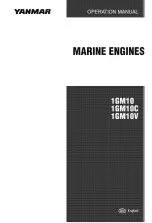
7
Safety Precautions
Keep the engine, gearbox and surrounding area clean, including the area
immediately below the engine.
Drives – Power Take Off Areas
Gearbox Output Flange
The purpose of the marine diesel propulsion engine is to provide motive power to
propel a vessel. Accordingly the gearbox output shaft rotates and its flange is
designed to be coupled to a propeller shaft by the installer. Steps must be taken
to ensure adequate guarding.
Forward End Drive
Engines are supplied with unguarded vee and poly vee belt drives to power the
fresh water pump and battery-charging alternator. The installer must ensure that
it is not possible for injury to occur by allowing accessibility to this area of the
engine. The drives can cause injury if personnel or clothing come in contact with
the moving belts or pulleys, when the engine is running.
Exhaust
Do not touch Hot Surfaces
Exhaust Outlet
Diesel marine propulsion engines emit exhaust gases at high temperatures –
around 400 - 500°C. Engines are supplied with either wet exhaust outlet (water
injection bend) or dry outlet (dry exhaust stub) – see engine price list. At the
outlet next to the heat exchange header tank, the exhaust outlet can become
very hot and if touched, can injure. This must be lagged or avoided by ensuring
adequate guarding. It is the responsibility of the installer to lag the exhaust
system if a dry system is used. Exhaust gases are harmful if ingested, the
installer must therefore ensure that exhaust lines are routed overboard and that
leakage into the vessel does not occur.
Fuel
Do not ingest liquids
Fuel Lines
Diesel engines are equipped with high pressure fuel injection pumps, if leakage
should occur, or pipes fracture, fuel at high pressure can be harmful. Skin must
be thoroughly cleaned in the event of contact with diesel fuel.
Fuel Supply Connections
Engines are supplied with 8mm fittings. The installer must ensure that when
connections are made, they are clean and free of leaks.








































